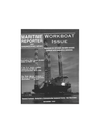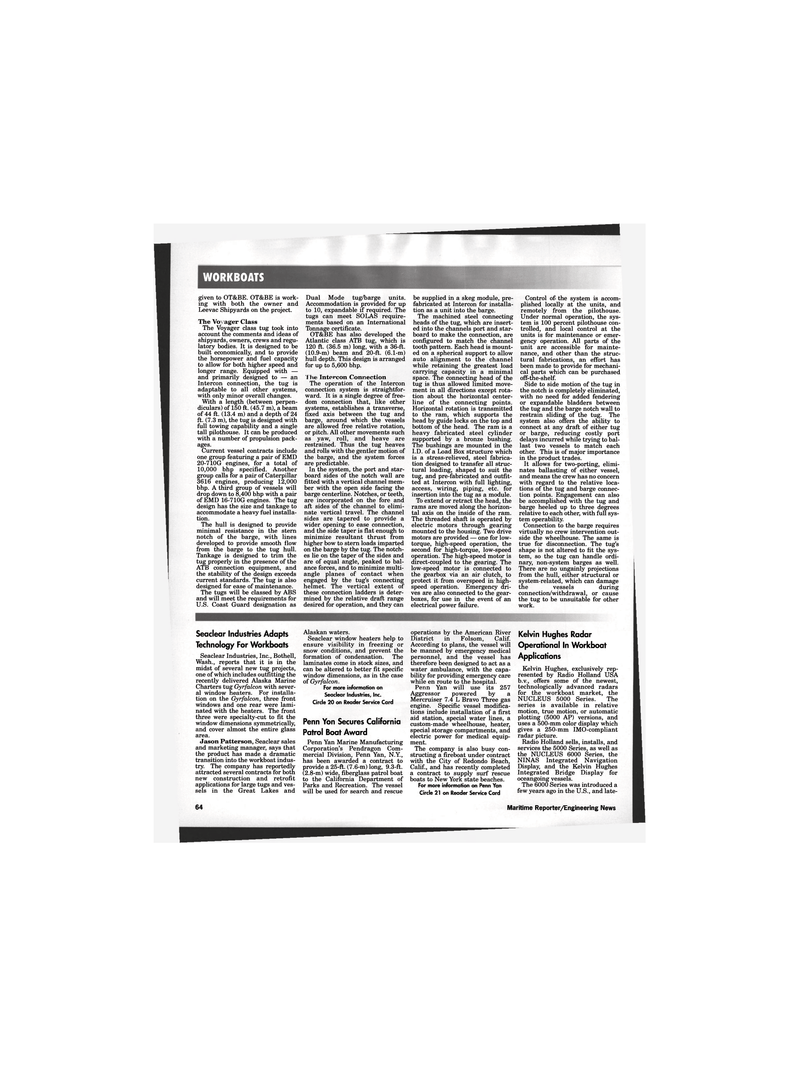
Page 63: of Maritime Reporter Magazine (November 1995)
Read this page in Pdf, Flash or Html5 edition of November 1995 Maritime Reporter Magazine
WORKBOATS given to OT&BE. OT&BE is work- ing with both the owner and
Leevac Shipyards on the project.
The Voyager Class
The Voyager class tug took into account the comments and ideas of shipyards, owners, crews and regu- latory bodies. It is designed to be built economically, and to provide the horsepower and fuel capacity to allow for both higher speed and longer range. Equipped with — and primarily designed to — an
Intercon connection, the tug is adaptable to all other systems, with only minor overall changes.
With a length (between perpen- diculars) of 150 ft. (45.7 m), a beam of 44 ft. (13.4 m) and a depth of 24 ft. (7.3 m), the tug is designed with full towing capability and a single tall pilothouse. It can be produced with a number of propulsion pack- ages.
Current vessel contracts include one group featuring a pair of EMD 20-710G engines, for a total of 10,000 bhp specified. Another group calls for a pair of Caterpillar 3616 engines, producing 12,000 bhp. A third group of vessels will drop down to 8,400 bhp with a pair of EMD 16-710G engines. The tug design has the size and tankage to accommodate a heavy fuel installa- tion.
The hull is designed to provide minimal resistance in the stern notch of the barge, with lines developed to provide smooth flow from the barge to the tug hull.
Tankage is designed to trim the tug properly in the presence of the
ATB connection equipment, and the stability of the design exceeds current standards. The tug is also designed for ease of maintenance.
The tugs will be classed by ABS and will meet the requirements for
U.S. Coast Guard designation as
Dual Mode tug/barge units.
Accommodation is provided for up to 10, expandable if required. The tugs can meet SOLAS require- ments based on an International
Tonnage certificate.
OT&BE has also developed the
Atlantic class ATB tug, which is 120 ft. (36.5 m) long, with a 36-ft. (10.9-m) beam and 20-ft. (6.1-m) hull depth. This design is arranged for up to 5,600 bhp.
The Intercon Connection
The operation of the Intercon connection system is straightfor- ward. It is a single degree of free- dom connection that, like other systems, establishes a transverse, fixed axis between the tug and barge, around which the vessels are allowed free relative rotation, or pitch. All other movements such as yaw, roll, and heave are restrained. Thus the tug heaves and rolls with the gentler motion of the barge, and the system forces are predictable.
In the system, the port and star- board sides of the notch wall are fitted with a vertical channel mem- ber with the open side facing the barge centerline. Notches, or teeth, are incorporated on the fore and aft sides of the channel to elimi- nate vertical travel. The channel sides are tapered to provide a wider opening to ease connection, and the side taper is flat enough to minimize resultant thrust from higher bow to stern loads imparted on the barge by the tug. The notch- es lie on the taper of the sides and are of equal angle, peaked to bal- ance forces, and to minimize multi- angle planes of contact when engaged by the tug's connecting helmet. The vertical extent of these connection ladders is deter- mined by the relative draft range desired for operation, and they can be supplied in a skeg module, pre- fabricated at Intercon for installa- tion as a unit into the barge.
The machined steel connecting heads of the tug, which are insert- ed into the channels port and star- board to make the connection, are configured to match the channel tooth pattern. Each head is mount- ed on a spherical support to allow auto alignment to the channel while retaining the greatest load carrying capacity in a minimal space. The connecting head of the tug is thus allowed limited move- ment in all directions except rota- tion about the horizontal center- line of the connecting points.
Horizontal rotation is transmitted to the ram, which supports the head by guide locks on the top and bottom of the head. The ram is a heavy fabricated steel cylinder supported by a bronze bushing.
The bushings are mounted in the
I.D. of a Load Box structure which is a stress-relieved, steel fabrica- tion designed to transfer all struc- tural loading, shaped to suit the tug, and pre-fabricated and outfit- ted at Intercon with full lighting, access, wiring, piping, etc. for insertion into the tug as a module.
To extend or retract the head, the rams are moved along the horizon- tal axis on the inside of the ram.
The threaded shaft is operated by electric motors through gearing mounted to the housing. Two drive motors are provided — one for low- torque, high-speed operation, the second for high-torque, low-speed operation. The high-speed motor is direct-coupled to the gearing. The low-speed motor is connected to the gearbox via an air clutch, to protect it from overspeed in high- speed operation. Emergency dri- ves are also connected to the gear- boxes, for use in the event of an electrical power failure.
Control of the system is accom- plished locally at the units, and remotely from the pilothouse.
Under normal operation, the sys- tem is 100 percent pilothouse con- trolled, and local control at the units is for maintenance or emer- gency operation. All parts of the unit are accessible for mainte- nance, and other than the struc- tural fabrications, an effort has been made to provide for mechani- cal parts which can be purchased off-the-shelf.
Side to side motion of the tug in the notch is completely eliminated, with no need for added fendering or expandable bladders between the tug and the barge notch wall to restrain sliding of the tug. The system also offers the ability to connect at any draft of either tug or barge, reducing costly port delays incurred while trying to bal- last two vessels to match each other. This is of major importance in the product trades.
It allows for two-porting, elimi- nates ballasting of either vessel, and means the crew has no concern with regard to the relative loca- tions of the tug and barge connec- tion points. Engagement can also be accomplished with the tug and barge heeled up to three degrees relative to each other, with full sys- tem operability.
Connection to the barge requires virtually no crew intervention out- side the wheelhouse. The same is true for disconnection. The tug's shape is not altered to fit the sys- tem, so the tug can handle ordi- nary, non-system barges as well.
There are no ungainly projections from the hull, either structural or system-related, which can damage the vessels during connection/withdrawal, or cause the tug to be unsuitable for other work.
Seaclear Industries Adapts
Technology For Workboats
Seaclear Industries, Inc., Bothell,
Wash., reports that it is in the midst of several new tug projects, one of which includes outfitting the recently delivered Alaska Marine
Charters tug Gyrfalcon with sever- al window heaters. For installa- tion on the Gyrfalcon, three front windows and one rear were lami- nated with the heaters. The front three were specialty-cut to fit the window dimensions symmetrically, and cover almost the entire glass area.
Jason Patterson, Seaclear sales and marketing manager, says that the product has made a dramatic transition into the workboat indus- try. The company has reportedly attracted several contracts for both new construction and retrofit applications for large tugs and ves- sels in the Great Lakes and
Alaskan waters.
Seaclear window heaters help to ensure visibility in freezing or snow conditions, and prevent the formation of condensation. The laminates come in stock sizes, and can be altered to better fit specific window dimensions, as in the case of Gyrfalcon.
For more information on
Seaclear Industries, Inc.
Circle 20 on Reader Service Card
Penn Yon Secures California
Patrol Boat Award
Penn Yan Marine Manufacturing
Corporation's Pendragon Com- mercial Division, Penn Yan, N.Y., has been awarded a contract to provide a 25-ft. (7.6-m) long, 9.3-ft. (2.8-m) wide, fiberglass patrol boat to the California Department of
Parks and Recreation. The vessel will be used for search and rescue operations by the American River
District in Folsom, Calif.
According to plans, the vessel will be manned by emergency medical personnel, and the vessel has therefore been designed to act as a water ambulance, with the capa- bility for providing emergency care while en route to the hospital.
Penn Yan will use its 257
Aggressor powered by a
Mercruiser 7.4 L Bravo Three gas engine. Specific vessel modifica- tions include installation of a first aid station, special water lines, a custom-made wheelhouse, heater, special storage compartments, and electric power for medical equip- ment.
The company is also busy con- structing a fireboat under contract with the City of Redondo Beach,
Calif., and has recently completed a contract to supply surf rescue boats to New York state beaches.
For more information on Penn Yan
Circle 21 on Reader Service Card
Kelvin Hughes Radar
Operational In Workboat
Applications
Kelvin Hughes, exclusively rep- resented by Radio Holland USA b.v., offers some of the newest, technologically advanced radars for the workboat market, the
NUCLEUS 5000 Series. The series is available in relative motion, true motion, or automatic plotting (5000 AP) versions, and uses a 500-mm color display which gives a 250-mm IMO-compliant radar picture.
Radio Holland sells, installs, and services the 5000 Series, as well as the NUCLEUS 6000 Series, the
NINAS Integrated Navigation
Display, and the Kelvin Hughes
Integrated Bridge Display for oceangoing vessels.
The 6000 Series was introduced a few years ago in the U.S., and late- 64 Maritime Reporter/Engineering News

 62
62

 64
64
